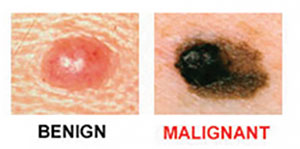With summer approaching, our thoughts naturally turn toward outdoor activities. As the weather warms up, it is important to understand the risks involved with prolonged, unprotected sun exposure. Approximately 1 in 5 Americans will develop skin cancer in their lifetime.
Did you know that skin cancer is the most common form of cancer in the United States? Fortunately, if caught early, it is also one of the most treatable.
Types of Skin Cancers
There are three main types of skin cancers: basal cell carcinoma, squamous cell carcinoma and melanoma. Basal cell and squamous cell carcinoma are the most common types of skin cancers; however, melanomas are the most dangerous.
Basal cell carcinomas (BCCs) can be tricky to diagnose, as they can look like other common skin disorders. Typically, BCCs have a white or yellowish scar-like appearance. Sometimes, the skin will appear shiny, waxy or tight. Other BCCs look like open sores that may bleed or crust. These sores will often heal up, only to begin bleeding again within a few days or weeks. A persistent sore that won’t heal is a common sign of a BCC and needs to be looked at by your dermatologist immediately.
Likewise, squamous cell carcinomas (SCCs) are locally destructive, but in some cases may spread internally and can be life threatening if ignored. They may look like scaly red patches, open sores or warts. Both BCC’s and SCCs are related to chronic, cumulative sun exposure and, therefore, tend to develop on parts of the body that have been exposed to the sun. In addition to a natural sun exposure, tanning-bed exposure is also known to increase the risk of developing BCCs and SCCs. And for those with fair skin and light hair and eyes, your risk is greater, too.
As worrisome as BCCs and SCCs are, melanomas are the skin cancers that get the most attention. This is for good reason – they are the deadliest.

Melanomas kill approximately 10,130 people in the US each year. Melanomas often resemble moles. Most melanomas are black or brown, but they can also be skin-colored, white, red, pink, purple or blue.
The easiest way to spot skin cancer early is by doing a full skin exam once a month. It should be done while you are fully unclothed, in front of a mirror and under a bright light. Start with your scalp and face, and work your way down your entire body. Look for any new growths, dark or bleeding lesions and changing moles. An easy way to remember what to look for when doing this self check is to remember your ABCDEs.
Self Screening: The ABCDE Exam
ABCDE stands for Asymmetry, Border, Color, Diameter and Evolving. Any new skin growth that is asymmetrical, has blurry or jagged borders, has a change in color, is larger than a pencil eraser, or is changing or evolving should be examined by a physician.
Signs of Melanoma
Melanoma may begin in a mole or on previously clear skin. Have a physician assess any mole that shows one or more of the following ABCDE characteristics:
 Asymmetry – Ono half does not match the other half.
Asymmetry – Ono half does not match the other half.
 Border is irregular – The mole’s edges are ragged, notched or blurred.
Border is irregular – The mole’s edges are ragged, notched or blurred.
 Color is not uniform – Mole mayappear shades of black, brown, tan, red, gray, white, pink or blue.
Color is not uniform – Mole mayappear shades of black, brown, tan, red, gray, white, pink or blue.
 Diameter is larger than 6 millimeters (mm) or 1/4 inch, about the size of a pencil eraser. Any sudden or continued increase in size is of special concern.
Diameter is larger than 6 millimeters (mm) or 1/4 inch, about the size of a pencil eraser. Any sudden or continued increase in size is of special concern.
 Evolving – The mole or lesion looks different from the rest, or is changing in size, shape or color.
Evolving – The mole or lesion looks different from the rest, or is changing in size, shape or color.
Be proactive.
Reapply sunscreen every two hours, wear protective clothing and practice your ABCDEs. And if you have any suspicious growths, don’t ignore them and see your physician immediately.
All three of our offices specialize in general, surgical and cosmetic dermatology, as well as skin cancer treatments that include Mohs surgery. The benefit to Mohs surgery is that it eliminates the guesswork from the surgical process as the physician is able to pinpoint the cancer’s location and ensure that the entire tumor has been excised. With a cure rate of 99%, Mohs provides a safe and effective treatment for most skin cancers.
To schedule an appointment for an examination by one of our providers, call us at one of our locations listed below. For more information, go to our website at www.tricitiesderm.com.
For more information contact Dermatology Associates.
Squamous cell carcinoma. (n.d.). Retrieved April 11, 2018, from https://www.aad.org/public/diseases/skin-cancer/squamous-cell-carcinoma#symptoms
Skin Cancer / Skin Cancer Facts / Common Skin Cancer Types. (n.d.). Retrieved April 11, 2018, from https://www.cancer.org/cancer/skin-cancer.html
